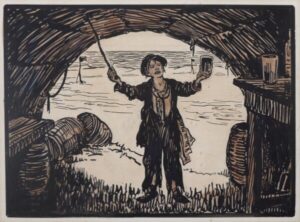Yeats, Jack Butler (1871-1957)
Jack Butler Yeats was born in London in 1871. He was the fourth son of the artist John Butler Yeats and the brother of the poet William Butler Yeats. Jack B himself wrote six novels, poetry and many plays. Most of his youth and school days were spent in Sligo with his maternal grandparents Elizabeth and William Pollexfen. His grandfather had been a seaman, and he inspired in the young Yeats boys a great love for the sea and the people who lived by it. Yeats stated later in life that every painting he made had somewhere in it a thought of Sligo.
Yeats’ early art education was at the Government School of Design in South Kensington and later at the prestigious Westminster School of Art. His family moved to Devon, by the sea, but Yeats visited Ireland regularly. After a visit to Wolf Tone’s grave in 1898, his subject matter was almost exclusively Ireland and its people. The following year his Sketches of Life in the West of Ireland was shown in Dublin and London. Drawings for journals, magazines and books, posters and theatrical production formed the basis of his early career. His artistic style developed greatly as he matured and he developed a unique style, quite unlike the work of his contemporaries. His techniques were not based on any particular movement or school but were a very personal response to his subject. His drawing style was bold and linear, sometimes caricatured in keeping with the larger than life characters he portrayed. In his drawing he managed to create a sense of solidity and volume by line alone. In paint, watercolour was his main medium. His theme was the West: island fisherman, tramps, race meetings. In all of his characters we see an involvement by the artist on a human level; these are not incidental figures but characters of depth, individuality, and pride. His individuals are at times humorous, sometimes sad, sometimes dark and menacing and always human.
In 1905, he travelled with playwright John Millington Synge around the coast of Mayo and Galway and also collaborated on the book The Aran Islander. This latter work was based on photographs taken by Synge and depicts the inhabitants of the islands engaged in typical scenes of thatching and fishing. By 1910, Yeats had moved to Ireland to live in Greystones, Co. Wicklow, again by the sea. Ireland was in search of a national identity and Yeats, who had great interest in the Irish Nationalist cause, was on a personal journey of discovery. The years of turmoil during The First World War and leading up to the Easter Rising of 1916 fanned the flames of Jack B. Yeats’ Irish Nationalism. (His painting of 1905 A Political Meeting, he regarded as one of his best works.) He wrote Bachelors Walk, in Memory which was a memorial to a group of people who had been shot by the British, he also sketched the lying-in-state of the Fenian leader, O’Donovan Rossa. By this time, he was considered the ‘most Irish’ of the Irish painters. Yeats moved to Dublin to be closer to the pulse of the times and here he threw himself into work documented the changing city and its people. The river Liffey, boxing matches, huddled pedestrians were all fodder for the artist to explore questions of life and humanity.
Yeats worked mostly in oils from about 1905; he used subdued colours with strong tonal contrasts to achieve dramatic effects. He applied the paint in broad flat strokes, his linear drawing-style showing through. By 1925, Yeats’ painting technique had significantly changed to an impasto style with vigorous brush marks and a brighter palette. From the 1940, line almost disappears from his work. In late works such as Grief, 1951, Men of Destiny,1946 and Returning From the Bathe, Mid-Day, 1948, solidity is defined by strong directional slashes of the palette knife, the characters emerge from the surface in ripples of light. He was painting from memory, seeking to capture the emotion of the event. Following the death of his wife in 1947 his work became even more expressive and experimental in theme. He expressed nostalgia for simpler times and used bright, optimistic colours. He painted with his fingers, with a palette knife, using paint directly from the tube in a controlled passion.
Showing the single result
